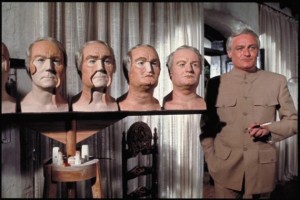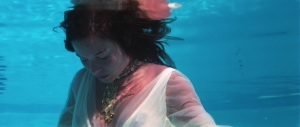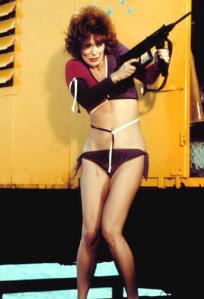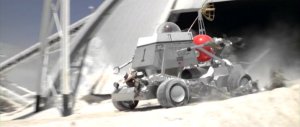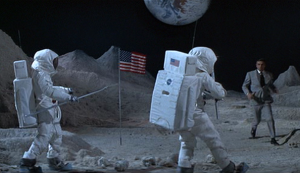Author’s note: I’d been meaning to write about Die Another Day for years. It was like some kind of suppressed bad memory that I couldn’t escape. Every time, it was too raw to go back and visit. But now, maybe now is the time. It’s late, it’s on ITV2 and there’s no escape.
There’s a problem I have with modern tv and films that I can trace back to Die Another Day. There are many faults with DAD – its lack of directional quality; the poor performances; the unconvincing villains; the presence of Madonna; the tsunami kitesurfing in front of the least convincing background in film history, CGI or no CGI; THE FUCKING INVISIBLE CAR, FOR CHRIST’S SAKE – but at its core there’s a kind of rotten, knowing wink. Not the raised eyebrow of Saint Roger – you knew and he knew he was camping it right up – or even George Lazenby, breaking the fourth wall, but something more tedious, more irritating, more anti-fun, anti-creativity than that.
This was a Bond coincided to hit the box office at the same time as Bond’s 50th anniversary, so there was a lot of goodwill around. Goodwill that was sucked dry by the time you make it through the awfulness to the end credits. Since it was an anniversary, why not refer to a few previous Bonds – after all, each and every Bond refers to the others in a variety of ways? But DAD does this in a way that’s so clunky, so cynical, so vile, you’re yearning for a bit of good honest product placement to take your mind off it. There’s a space station covered in diamonds, for heaven’s sake, basically the whole point of Diamonds Are Forever. There’s self-referential and then there’s just copying.
Somewhere along the line, someone forgot that films and TV and books and whatnot are meant to entertain you first. That’s the primary purpose of any piece of art. Make you enjoy it, in and of itself. With DAD, like the modern Sherlock or Batman, it seems to be written for ultra fans rather than the general public. It doesn’t seem to have been made to be a good film, but rather to fulfil a set of criteria and to be like other Bonds. It’s got all the ingredients of a Bond, just nowhere near in the right order or at the right pitch.
Die Another Day is the worst film ever. No, not worst Bond film. Worst film. Actually, it’s probably the worst thing ever, if we imagine – and I do – that Country House by Blur never happened. Die Another Day is shit, but, more than that, it’s hurtfully shit. It’s the sort of thing that insults you for watching it. It’s hateful, hateful slurry. It’s not designed to be any good. It’s designed to make you nod and think, oh, clever. Bugger off! Entertain me.
This isn’t entertaining, though. This is empty. All the wit and danger that ever made Bond any good is absent. It’s just a series of setpieces – not cracking ones, at that – glued together.
Don’t get me wrong, I like Bond, even the crap ones. And I like Brosnan as Bond. Goldeneye is terrific. But this. This one. This. This heap of shit.
Madonna’s miserable title track notwithstanding, things begin promisingly enough. There’s a daft hovercraft chase and Bond gets captured and tortured. Brosnan attempts an approximation of acting. It goes bad, quickly. Brosnanbond stops his heart – that’s right, stops his heart, by thinking of bad things – in order to lure doctors into his hospital room, beat them up and effect an escape. Mumbling the reasonable tagline “I’m checking out” in an accent so obscure it manages to miss every single country on earth, Brosnan gargles “I’m chicken art”. And chicks art. That’s the first warning, and we’re about twenty minutes in. But it gets deeper. Worse.
Brosnanbond glides over to Cuba, via Hong Kong. He totally unnecessarily gawps over Halle Berry, who is delighted to be gawped upon and ends up fucking him in a scene of such mediocre intimacy that you’d be less squirmy sitting through hardcore fistfucking with your mum and dad over Christmas dinner.
Via a pisspoor promotional video for British Airways, we’re transported to London, where villain Gustav Graves drops in via union jack parachute – as annoying a nod as possible Alan Partridge’s favourite bit in The Spy Who Loved Me – and proceeds to hold the worst press conference in film history.
“SO, MR GRAVES, ER, BACKSTORY AND PLOTPOINT?”
“Yes, I intend to be QUITE EVIL HAHAHA oh er I mean yes.”
Madonna arrives, as if she’s been wheeled into place. Bond and Graves have a snarling and grunting competition in the form of a dismally unhomoerotic swordfight, in which a sword is thrown into a wall and actually makes – actually makes – that boingy twanging noise you get when you hold down a plastic ruler and wallop the end.
No, we cannot avoid it any longer. We must talk about the fucking invisible car.
CGI was in its prodigal stages back then. We’d seen the delights of greenscreeen brought to the fore in the beloved Star Wars prequels, so the Bond people must have thought: that’ll do for us. How can we use this technology in a way that can only enhance the franchise? Ah yes, a fucking invisible car.
Don’t do it. You’re saying to yourself. Don’t do it. Don’t do it. Do anything but that. Don’t do the fucking invisible car.
But they do. They do it. From the moment the Aston Martin flickers into life, you know this Bond has gone way beyond acceptable silliness, into the realms of “what the actual fuck am I watching? And why?”
An invisible car. They made an invisible car. They did a film with an invisible car. You can’t get around it. I mean, there’s a certain sackload of salt you have to take on board with every bit of Bond, and you know you’re a willing participant in the suspension of your disbelief, but how far are you meant to be able to suspend it? As far as a fucking invisible car? I can’t even. How can anyone? Brosnanbond had managed to (just about) get away with a big remote controlled car in Tomorrow Never Dies, and we winced along but carried ourselves through it as best we could, but a fucking invisible car. A. Fucking. Invisible. Car. How? Why? Who? I want names. Give me names. I want to go around to their houses – nice houses, I bet – and ask each and every single one of them just what they thought they might have been playing at when they agreed to this travesty.
Bond has his own holodeck – of course he does – and walks through a series of clunkily-placed props from previous films on his way to getting the invisible car. In fairness, the appallingness of what’s about to happen is foreshadowed a tad. But nothing can prepare you. Nothing can make you steel yourself enough for the invisible ruddy shitting fucking Jesus Christ Mary Mother Of God car.
Bond drives it to Iceland. There’s an ice palace. An ice palace! In most films (yes yes, except Superman), the presence of an ice palace might be the very worst thing, the thing to end all things, the thing that makes you think this film is beyond salvation. In Die Another Day? Not even in the top three. Invisible car > tsunami kitesurfing > iceboatplane > villain parachuting into press conference outside Buckingham Palace > ice palace.
We must move on again, now to the kitesurfing tsunami CGI debacle. I mean, you always knew it wasn’t Roger Moore skiing down a mountain, and the back projection was pretty rudimentary, but somehow it didn’t seem as bad. While attempting to escape the villains’ space station laser weapon in an iceboatplane, Bond falls a million miles down off a glacier – but luckily eludes the ensuing tsunami by MacGuyvering a parachute into a piece of kitesurfing equipment. This isn’t a couple of seconds quickly forgotten about: the sequence goes on for ages. As if they’re proud of it, or something. Everything about this sequence is so bad-its-good-it’s-bad, I remember howls of laughter in the cinema.
Howls that quickly turned to groans when the Invisible Fucking Car rolled into view a couple of minutes later. This was it. We couldn’t take it. We had been saturated with the terribleness of it all, and now we could withstand no more. I think a couple of people walked out of the cinema at that point. Whether they were bored or disgusted is something that history doesn’t recall, but either way, I knew how they felt. How could it have come to this? Where did it go so wrong?
There’s an ending to the film, of course, but it’s hardly worth describing. It’s all over by then. Your loyalty to Brand Bond is undermined, quite fatally. Daniel Craig would come pouting out of the sea in a pair of Speedos to try and resurrect it, but by then I think the damage was done, and I didn’t like his tedious solemnity. No, DAD is what killed off Bond. Killed him forever, as far as I’m concerned.




